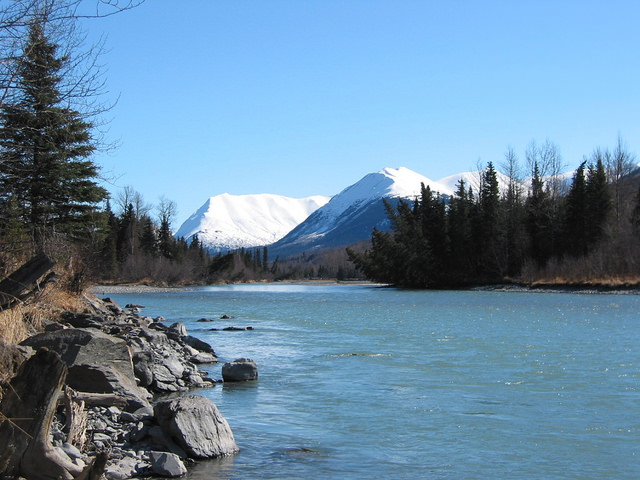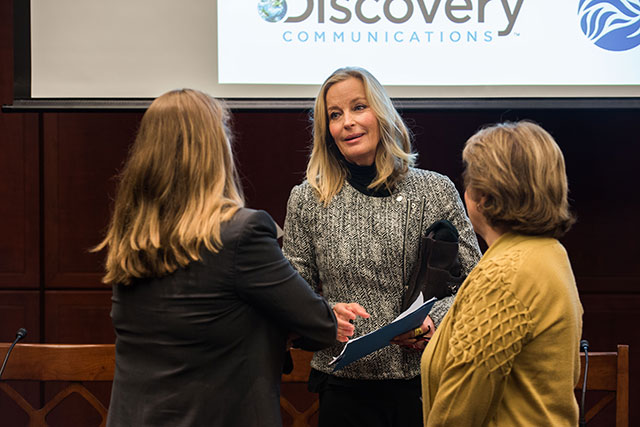 Actress Bo Derek, who is a WildAid Board Member and has also served as a Special Envoy of the Secretary of State for Wildlife Trafficking, spoke passionately about the need to protect wildlife from trafficking. She became interested in the issue after visiting the Galapagos Islands in Ecuador. Photo by Frank Kohn/USFWS
Actress Bo Derek, who is a WildAid Board Member and has also served as a Special Envoy of the Secretary of State for Wildlife Trafficking, spoke passionately about the need to protect wildlife from trafficking. She became interested in the issue after visiting the Galapagos Islands in Ecuador. Photo by Frank Kohn/USFWS
We recently stopped by Capitol Hill to highlight the work of the U.S. Fish and Wildlife Service and partners including JetBlue, Discovery Communications, WildAid and the U.S. Wildlife Trafficking Alliance in the fight against wildlife trafficking. We held a briefing for congressional staff and the public, which allowed us to amplify our messages to Americans and consumers abroad about how they can help reduce demand for illegally traded wildlife. People who travel abroad will sometimes unknowingly make purchases of food, souvenirs, clothing and medicine that are made from imperiled wildlife. Endangered and threatened animals may even be sold as pets.
Here’s a quick overview of how each of these partners is making a difference:
 Our Danielle Kessler moderated a panel with partners including WildAid, Discovery Communications, JetBlue and the U.S. Wildlife Trafficking Alliance. Photo by Frank Kohn/USFWS
Our Danielle Kessler moderated a panel with partners including WildAid, Discovery Communications, JetBlue and the U.S. Wildlife Trafficking Alliance. Photo by Frank Kohn/USFWS
WildAid
The #StopWildlifeTrafficking campaign features celebrities in airport billboards and PSAs that ask consumers to protect wildlife by questioning their purchasing choices, particularly for items like ivory. The cast of the Walking Dead TV show is featured in one PSA; a broader range of celebrities are featured in other PSAs. And the video infographic below provides some of the hard-truths about how trafficking is impacting species. More PSAs with additional celebrities will soon be released.
A WildAid campaign in China featuring basketball star Yao Ming and other celebrities has helped to reduce consumption of shark-fin soup by 50-70 percent. This is just one example of WildAid’s success in reducing demand, and we’re hopeful that their expertise in changing consumer behavior will lead to similar successes for species being impacted by U.S. consumers.
JetBlue
The Caribbean is one of the most popular destinations for many of JetBlue’s flights and protecting what makes the Caribbean special is critical to the company’s business interests. JetBlue in partnership with the Service produced a short film featuring local conservation leaders in Jamaica, Trinidad and Tobago, and Grenada that seeks to empower consumers to serve as guardians of Caribbean wildlife such as sea turtles, coral, and blue and gold macaws. The film is being shown on JetBlue flights, which carry 35 million passengers each year.
Discovery Communications
In September, at the most recent international wildlife trade conference (CITES COP17), Discovery Communications released a new PSA created in collaboration with the Service. It is narrated by actor Edward Norton and is now airing on Discovery networks in the United States and abroad. The PSA was part of the company’s mission to not only inspire people, but also empower them to protect the world’s wildlife and natural wonders
U.S. Wildlife Trafficking Alliance
The U.S. Wildlife Trafficking Alliance has recruited a large number of companies and organizations under one umbrella to work together to take on the wildlife trafficking crisis. Sara Walker, Executive Director of the Alliance, explained that while it’s not an issue that has been on the radar (yet) for many companies, there is relevance and a role for them to play in helping to protect wildlife. Some big names have already joined the Alliance in addition to Discovery, JetBlue, and WildAid, including Google, eBay, Ralph Lauren, and Tiffany.

Senator Jeff Flake (R-AZ) meets with Office of Law Enforcement Chief, William C, Woody, U.S. Fish and Wildlife Service staff, Bo Derek and our partners. Senator Flake was a lead co-sponsor of the recently passed END Wildlife Trafficking Act. Photo by USFWS
Congressional Interest in Combating Wildlife Trafficking is Significant
Giving us new tools to fight wildlife trafficking, last year Congress passed, and the President signed into law the Eliminate, Neutralize and Disrupt (END) Wildlife Trafficking Act. This legislation demonstrates that protection of wildlife, both domestically and abroad, is a priority for Congress that has broad, bipartisan support.
Following the briefing, other Members of Congress and their staff took time to meet with us and our partners to discuss the progress we are making.
Senator Coons, one of the lead sponsors of the END Wildlife Trafficking Act said, “The collaboration of the U.S. Fish and Wildlife Service with private sector leaders is essential if we are to meet our goal of quickly and effectively combatting wildlife trafficking and poaching. Countless species worldwide, including well-known ones like elephants, sea turtles, and rhinos, could potentially be lost if we don’t take action. The partnership of well-respected advocacy organizations, like WildAid and the U.S. Wildlife Trafficking Alliance, will be critical to combine the strength of all sectors to empower Americans to know what they can do to help protect wildlife around the world. I am proud of the work Congress did earlier this year to pass the END Wildlife Trafficking Act, which provides congressional authorization and guidance for this important work.”
Senator Flake, another lead sponsor of the END Wildlife Trafficking Act stated: “Wildlife trafficking is a multibillion-dollar industry that not only threatens to extinguish iconic wildlife, but also fuels an illicit industry that threatens global security. I am thankful that the U.S. Fish and Wildlife Service and other stakeholders are bringing awareness to this important issue.”
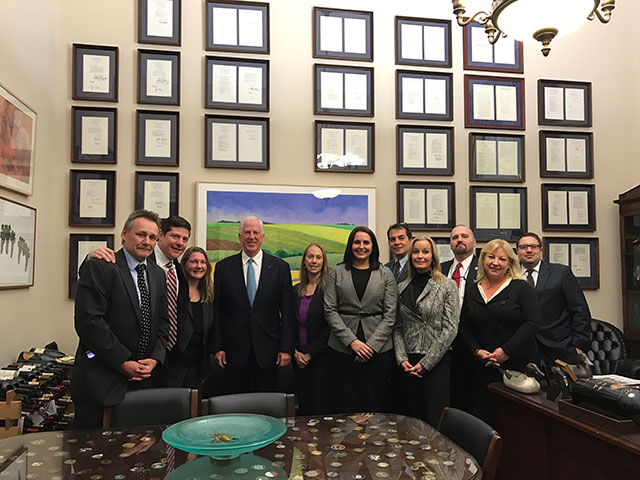 Congressman Mike Thompson (D-CA-5) meets with Bo Derek, U.S. Fish and Wildlife Service staff and our partners. Photo by USFWS
Congressman Mike Thompson (D-CA-5) meets with Bo Derek, U.S. Fish and Wildlife Service staff and our partners. Photo by USFWS
The Service looks forward to continuing to work with Congress on the important issue of combating wildlife trafficking.







 New York City Parks Commissioner Mitchell J. Silver (L) prepares to release a rehabilitated dove in Central Park, following the lead of Service biologist Scott Johnston. Photo by USFWS
New York City Parks Commissioner Mitchell J. Silver (L) prepares to release a rehabilitated dove in Central Park, following the lead of Service biologist Scott Johnston. Photo by USFWS  Jamal, a student at International High School, introduces himself to Helen Hays, Director of the Great Gull Island Project with the American Museum of Natural History. He wants to pursue biology and science as a career and is signing up to do volunteer field work on Great Gull Island. Photo by Margaret Byrne/USFWS
Jamal, a student at International High School, introduces himself to Helen Hays, Director of the Great Gull Island Project with the American Museum of Natural History. He wants to pursue biology and science as a career and is signing up to do volunteer field work on Great Gull Island. Photo by Margaret Byrne/USFWS  A bird walk through a Chicago area park focused on the significance of birds in Chinese culture. Photo courtesy of Audubon Great Lakes
A bird walk through a Chicago area park focused on the significance of birds in Chinese culture. Photo courtesy of Audubon Great Lakes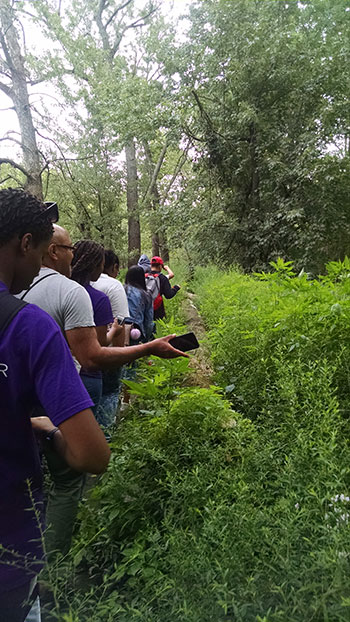
 Visitors to Busch Gardens Tampa Bay flock to the banding station to learn how the Service tracks birds. Photo by USFWS
Visitors to Busch Gardens Tampa Bay flock to the banding station to learn how the Service tracks birds. Photo by USFWS 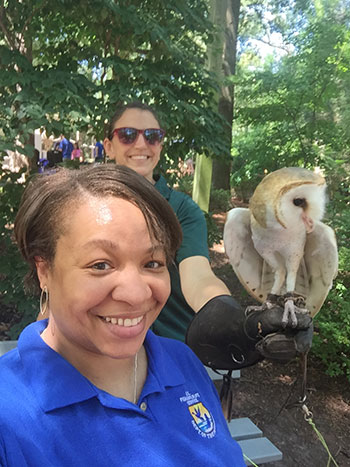
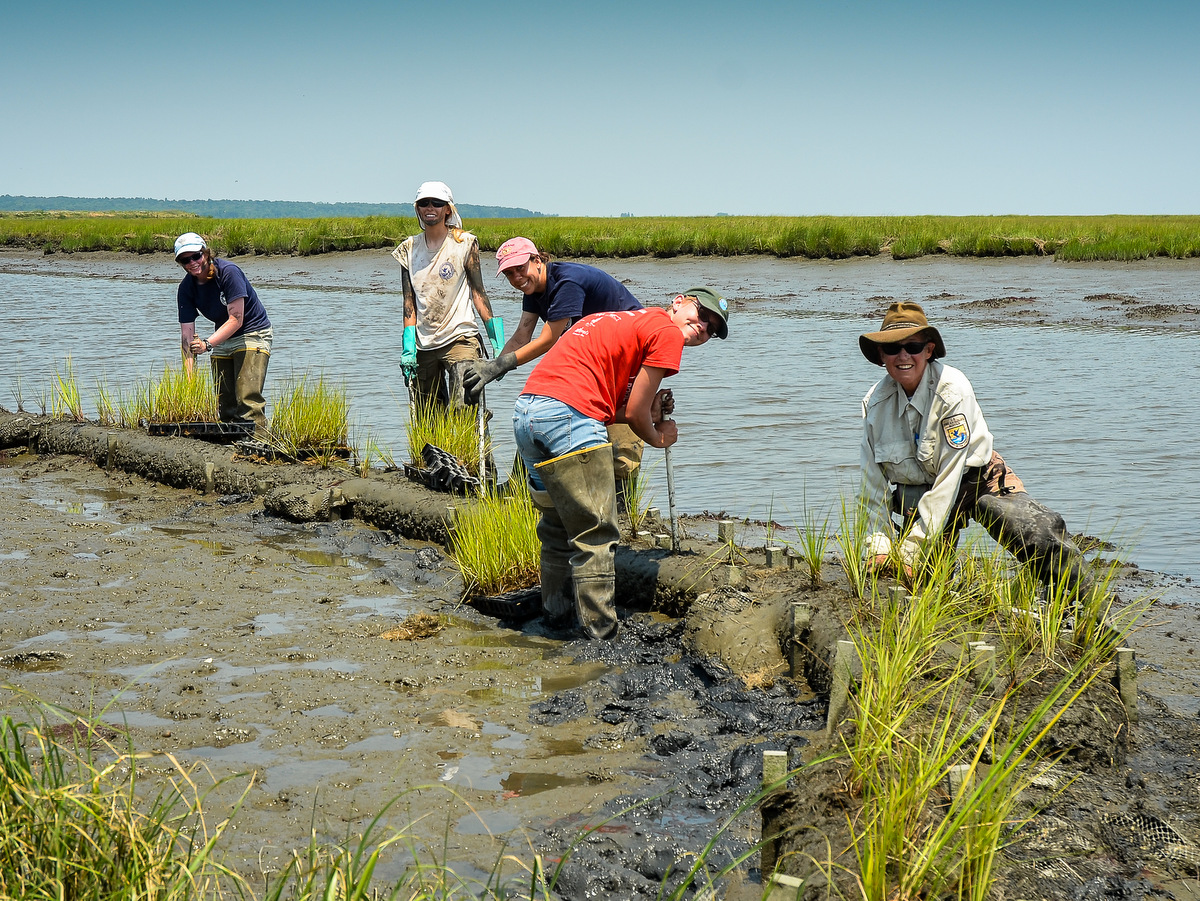 Staff and volunteers restoring tidal marsh at Edwin B. Forsythe National Wildlife Refuge. Photo by Don Freiday/USFWS
Staff and volunteers restoring tidal marsh at Edwin B. Forsythe National Wildlife Refuge. Photo by Don Freiday/USFWS Released pangolin finding its way in the wild. Photo by MENTOR-POP
Released pangolin finding its way in the wild. Photo by MENTOR-POP 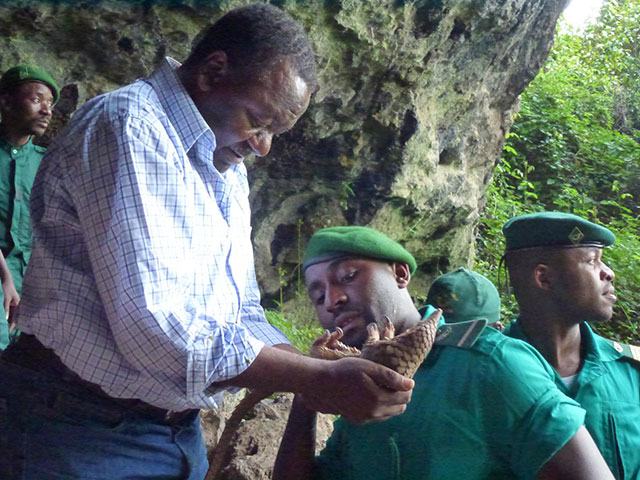 Francis Tarla, the MENTOR-POP Coordinator, provides a close-up look at the soon-to-be-released pangolin to the Conservator of Mbi Crater Forest Reserve and the North-West Regional Chief of Wildlife. Photo by Tobias Feldt
Francis Tarla, the MENTOR-POP Coordinator, provides a close-up look at the soon-to-be-released pangolin to the Conservator of Mbi Crater Forest Reserve and the North-West Regional Chief of Wildlife. Photo by Tobias Feldt Dr. Tobias Feldt (5th from right) and some members of the delegation that released the white-bellied pangolin. Photo by MENTOR-POP
Dr. Tobias Feldt (5th from right) and some members of the delegation that released the white-bellied pangolin. Photo by MENTOR-POP.jpg) A bald eagle cruises over
A bald eagle cruises over .jpg) A bloodied bald eagle after downing a meal at
A bloodied bald eagle after downing a meal at .jpg) A bald eagle perches at
A bald eagle perches at .jpg) A bald eagle patrols
A bald eagle patrols  Actress Bo Derek, who is a WildAid Board Member and has also served as a Special Envoy of the Secretary of State for Wildlife Trafficking, spoke passionately about the need to protect wildlife from trafficking. She became interested in the issue after visiting the Galapagos Islands in Ecuador. Photo by Frank Kohn/USFWS
Actress Bo Derek, who is a WildAid Board Member and has also served as a Special Envoy of the Secretary of State for Wildlife Trafficking, spoke passionately about the need to protect wildlife from trafficking. She became interested in the issue after visiting the Galapagos Islands in Ecuador. Photo by Frank Kohn/USFWS  Our Danielle Kessler moderated a panel with partners including WildAid, Discovery Communications, JetBlue and the U.S. Wildlife Trafficking Alliance. Photo by Frank Kohn/USFWS
Our Danielle Kessler moderated a panel with partners including WildAid, Discovery Communications, JetBlue and the U.S. Wildlife Trafficking Alliance. Photo by Frank Kohn/USFWS 
 Congressman Mike Thompson (D-CA-5) meets with Bo Derek, U.S. Fish and Wildlife Service staff and our partners. Photo by USFWS
Congressman Mike Thompson (D-CA-5) meets with Bo Derek, U.S. Fish and Wildlife Service staff and our partners. Photo by USFWS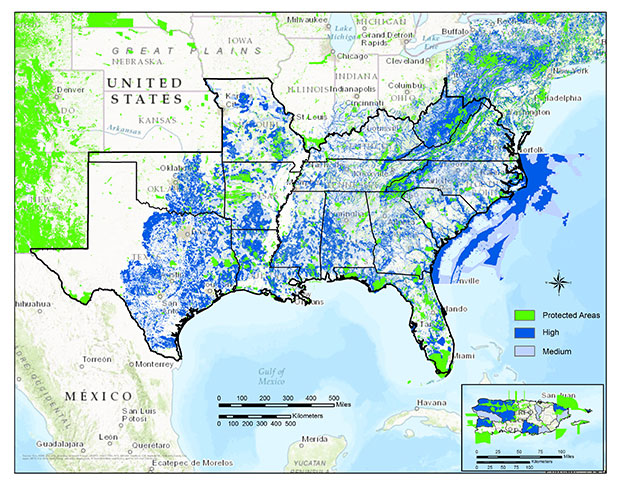 The SECAS Blueprint 1.0 shown here represents lands with high conservation value, but it is not an acquisition boundary. In fact, much of the “high” priority is already in the conservation estate, while the “medium” areas are important for promoting and maintaining connectivity.
The SECAS Blueprint 1.0 shown here represents lands with high conservation value, but it is not an acquisition boundary. In fact, much of the “high” priority is already in the conservation estate, while the “medium” areas are important for promoting and maintaining connectivity.  Subsistence users transport harvested caribou in Northwestern Alaska. Photo by Lisa Maas/USFWS
Subsistence users transport harvested caribou in Northwestern Alaska. Photo by Lisa Maas/USFWS 